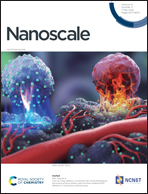Assembly of alpha-helical transmembrane pores through an intermediate state†
Abstract
Pore-forming alpha-helical proteins are well known for their dynamic assembly mechanism and it has been challenging to delineate the pore-forming structures in membranes. Previously, attempts have been made to elucidate their assembly mechanism and there is a large gap due to complex pathways by which these membrane-active pores impart their effect. Here we demonstrate a multi-step structural assembly pathway of alpha-helical peptide pores formed by a 37 amino acid synthetic peptide, pPorU, based on the natural porin from Corynebacterium urealyticum using single-channel electrical recordings. More specifically, we report detectable intermediate states during the membrane insertion and pore formation of pPorU. The fully assembled pore exhibited unusually large stable conductance, voltage-dependent gating, and functional blockage by cyclic sugars generally applicable to a range of transmembrane pores. Furthermore, we used rationally designed mutants to understand the role of specific amino acids in the assembly of these peptide pores. Mutant peptides that differ from wild-type peptides produced noisy and unstable intermediate states and low conductance pores, demonstrating sequence specificity in the pore-formation process supported by molecular dynamics simulations. We suggest that our study contributes to understanding the mechanism of action of naturally occurring alpha-helical pore-forming proteins and should be of broad interest to build peptide-based nanopore sensors.



 Please wait while we load your content...
Please wait while we load your content...